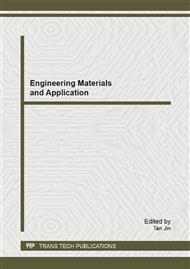[1]
B. O'Regan, M. Grätzel, A low-cost, high-efficiency solar cell based on dye-sensitized colloidal TiO2 films, Nature 353 (1991) 737-740.
DOI: 10.1038/353737a0
Google Scholar
[2]
H. Imahori, T. Umeyama, S. Ito, Large p-aromatic molecules as potential sensitizers for highly efficient dye-sensitized solar cells, Acc. Chem. Res. 42 (2009) 1809-1818.
DOI: 10.1021/ar900034t
Google Scholar
[3]
A. Mishra, M. Fischer, P. Bäuerle, Metal-free organic dyes for dye-sensitized solar cells: from structure: property relationships to design rules, Angew. Chem. Int. Ed. 48 (2009) 2474-2499.
DOI: 10.1002/anie.200804709
Google Scholar
[4]
M. K. Nazeeruddin, A. Kay, I. Rodicio, R. Humphry-Baker, E. Mueller, P. Liska, N. Vlachopoulos, M. Grätzel, Conversion of light to electricity by cis-X2bis (2, 2'-bipyridyl-4, 4'-dicarboxylate) ruthenium(II) charge-transfer sensitizers (X = Cl-, Br-, I-, CN-, and SCN-) on nanocrystalline titanium dioxide electrodes, J. Am. Chem. Soc. 115 (1993).
DOI: 10.1021/ja00067a063
Google Scholar
[5]
Y. Luo, D. Li, Q. Meng, Towards optimization of materials for dye-sensitized solar cells, Adv. Mater. 21 (2009) 4647-4651.
DOI: 10.1002/adma.200901078
Google Scholar
[6]
A. Reynal, A. Forneli, E. Palomares, Dye structure-charge transfer process relationship in efficient ruthenium-dye based dye sensitized solar cells, Energy Environ. Sci. 3 (2010) 805-812.
DOI: 10.1039/b925488a
Google Scholar
[7]
Y. Sun, A. C. Onicha, M. Myahkostupov, F. N. Castellano, Viable alternative to N719 for dye-sensitized solar cells, ACS Appl. Mater. Interfaces 2 (2010) 2039-(2045).
DOI: 10.1021/am100311m
Google Scholar
[8]
Y. Cao, Y. Bai, Q. Yu, Y. Cheng, S. Liu, D. Shi, F. Gao, P. Wang, Dye-sensitized solar cells with a high absorptivity ruthenium sensitizer featuring a 2-(hexylthio)thiophene conjugated bipyridine, J. Phys. Chem. C 113 (2009) 6290-6297.
DOI: 10.1021/jp9006872
Google Scholar
[9]
Z. Yu, H. M. Najafabadi, Y. Xu, K. Nonomura, L. Sun, L. Kloo, Ruthenium sensitizer with a thienylvinylbipyridyl ligand for dye-sensitized solar cells, Dalton Trans. 40 (2011) 8361-8366.
DOI: 10.1039/c1dt10210a
Google Scholar
[10]
R. Jitchati, Y. Thathong, K. Wongkhan, A cheap synthetic route to commercial ruthenium N3 dye for sensitizing solar cell applications, Adv. Mat. Res. 488-489 (2012) 1049-1054.
DOI: 10.4028/www.scientific.net/amr.488-489.1049
Google Scholar
[11]
R. Jitchati, Y. Thathong, K. Wongkhan, Three synthetic routes to a commercial N3 dye, Int. J. App. Phy Mat. 2 (2012) 107-110.
DOI: 10.7763/ijapm.2012.v2.64
Google Scholar



